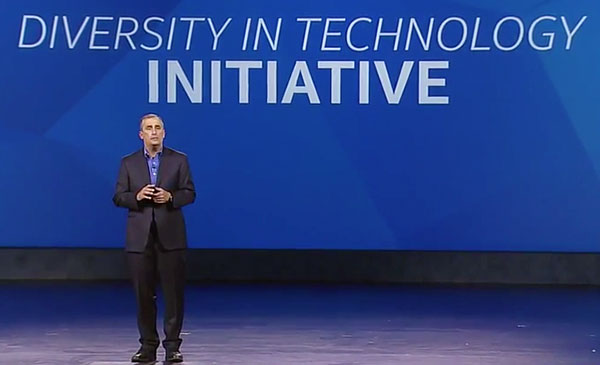Intel will invest US$300 million over the next five years to promote gender and racial diversity, CEO Brian Krzanich announced Tuesday at CES 2015.
The company plans to have full representation at all levels in its workforce by 2020.
That’s close to 100,000 people — Intel cut its global workforce of 107,000 by about 5 percent last year.
“This is a highly relevant issue, and one that we all need to address,” Krzanich said. “It’s not good enough to say we value diversity and then have our workplaces and our industry not reflect the full availability of a talent pool of women and underrepresented minorities.”
The move “isn’t just good business,” Krzanich said. “It’s the right thing to do.”
Intel may have launched a new virtuous cycle.
“This investment is in complete alignment with a major global megatrend towards empowerment of women, which is motivated by both moral and economic reasons,” said David Frigstad, CEO at Frost & Sullivan.
“The investment in diversity at all levels of an organization is proving to drive significantly higher performance results,” he told the E-Commerce Times.
Intel’s Commitment
Intel will “significantly increase our hiring, progression, retention of women and minorities in the workplace,” Krzanich said.
This “is going to be difficult to achieve,” he acknowledged, and that’s where the $300 million funding comes in.
The money will go to grow Intel’s diverse population, fund initiatives to support more participation and positive representation of women and underrepresented minorities in technology and gaming, and increase the pipeline of women and diverse candidates entering the technology field, Krzanich remarked.
“We will, as good engineers, measure and report our progress on a regular basis with full transparency,” he promised. Intel will “hold our leaders accountable by tying their pay to our progress.”
This past year saw, on one hand, “a generational shift in attitudes towards homosexuals and the right to marry,” and on another, “missteps such as Microsoft CEO Satya Nadella’s harrowing ‘karma’ comment, to the harrowing treatment some women suffered relating to Gamergate,” commented Charles King, principal analyst at Pund-IT.
“Let’s hope [Intel] inspires lots of followers,” he told the E-Commerce Times.
The Misogynist World of High-Tech
In 2014, the high-tech world was rocked by Gamergate, a controversy that erupted over sexism in video game culture after the ongoing harassment of women in the gaming industry was made public.
Female game developers and journalists covering the gaming industry have been subjected to physical, verbal and online abuse ranging from intimidation to threats of rape and death, often in obscene language.
Brianna Wu, cofounder and head of development at independent gaming publisher Giant Spacekat, had to flee her home with her family in October after receiving violent rape and death threats from an anonymous Twitter user who posted her home address online.
The threats were triggered by her criticism of Gamergate.
In March, prominent developer Julie Ann Horvath stormed out of GitHub, alleging the company had ignored persistent harassment directed toward her by an engineer, as well as one of GitHub’s cofounders and his wife.
No More GamerGates!
The gaming industry, notoriously a hotbed of sexism, may be in for an overhaul.
“Intel is the primary technology used in gaming PCs, and this puts them on notice,” Rob Enderle, principal analyst at the Enderle Group, told the E-Commerce Times.
“A lot of these firms get funding from Intel, and the implication is, if they aren’t in compliance with its policies, they could lose their funding,” he continued. “If you’re a gaming company and your people exhibit bad behavior, you will be at risk.”
Further, Intel’s size and prominence in the high-tech industry “will certainly send a message to the rest of the industry,” Enderle said, “and will give activists the ammunition to pressure other firms.”














































Social Media
See all Social Media